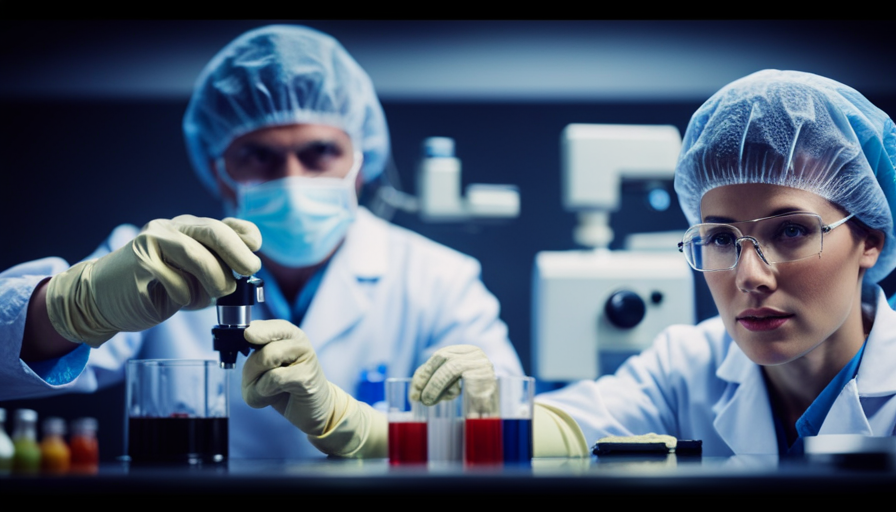As I delved into the world of raw food, I discovered a surprising danger lurking beneath its seemingly healthy facade: germs. These are the same germs that can cause issues with our digestive systems and lead to foodborne illnesses. Though it may be a concerning realization, it is extremely important.
In this article, I will explore the fascinating realm of raw food germs and delve into the methods used to diagnose them.
When we talk about raw food, we’re referring to any food that is consumed in its natural, uncooked state. While this dietary choice boasts numerous health benefits, it also carries a certain level of risk. Raw food is a breeding ground for a variety of germs, including bacteria, viruses, and parasites. These harmful microorganisms can cause a range of illnesses, from mild gastrointestinal discomfort to severe and potentially life-threatening conditions.
To ensure the safety of raw food consumption, it is crucial to understand the types of germs commonly found in raw food and the methods used to diagnose them. By employing microbiological testing methods and implementing strict food safety measures, we can minimize the risk of contamination and promote the safe consumption of raw food.
So, let’s dive into the world of raw food germs and uncover the vital role of diagnosis in safeguarding our health.
Key Takeaways
- Raw food can harbor harmful bacteria, viruses, and parasites that cause foodborne illnesses.
- Common types of germs found in raw food include Salmonella, E. coli, Listeria, and Campylobacter.
- Timely diagnosis of foodborne pathogens is important for identifying and controlling outbreaks.
- Microbiological testing methods include culture-based testing, molecular-based testing, and rapid detection methods.
Understanding Raw Food and its Potential Risks
So, you’re probably wondering about the dangers of raw food and how it can make you sick, right? Well, let’s dive into the potential health hazards and the importance of raw food safety.
Raw food, such as fruits, vegetables, and meat, can harbor harmful bacteria, parasites, and viruses that can cause foodborne illnesses. These pathogens can contaminate raw food through various sources, including soil, water, and unsanitary handling practices.
To ensure the safety of raw food, it’s crucial to handle and prepare it properly. Washing fruits and vegetables thoroughly can help remove dirt, pesticides, and some bacteria. However, it’s important to note that washing may not completely eliminate all pathogens. Additionally, proper storage, such as keeping raw meat separate from other foods, can prevent cross-contamination.
Common types of germs found in raw food include Salmonella, E. coli, Listeria, and Campylobacter. These bacteria can cause symptoms like diarrhea, abdominal pain, fever, and vomiting. In severe cases, they can lead to dehydration and even life-threatening complications.
Understanding the potential risks of raw food and practicing safe handling and preparation techniques are essential for maintaining good health. By following proper food safety guidelines, you can reduce the risk of foodborne illnesses and enjoy the benefits of raw food without compromising your well-being.
Now, let’s explore the different diagnostic methods used to identify these harmful germs in raw food.
Common Types of Germs Found in Raw Food
Eating contaminated raw food can lead to various illnesses caused by bacteria, viruses, and parasites, which can be detected through proper testing and analysis. Raw food safety is crucial in order to prevent these health risks. Understanding the types of germs commonly found in raw food is essential for implementing effective prevention strategies.
Here is a table outlining some common types of germs found in raw food:
| Germs | Source | Symptoms |
|---|---|---|
| Salmonella | Raw eggs, poultry | Diarrhea, fever |
| E. coli | Undercooked beef | Stomach cramps, diarrhea |
| Listeria | Soft cheeses, deli meats | Fever, muscle aches |
| Norovirus | Shellfish, fruits | Vomiting, nausea |
| Toxoplasma gondii | Raw meat, cat feces | Flu-like symptoms |
To ensure raw food safety, it is important to handle and store raw food properly, wash hands thoroughly, and cook food to the recommended internal temperature. Additionally, diagnosing germs in raw food is of utmost importance to prevent outbreaks and protect public health.
Transitioning into the subsequent section about the importance of diagnosing germs in raw food, understanding the methods and techniques used for diagnosis is crucial for effective prevention and control.
Importance of Diagnosing Germs in Raw Food
Understanding the significance of diagnosing pathogens present in uncooked food is crucial for safeguarding public health and preventing potential outbreaks.
Raw food, such as fruits, vegetables, and meats, can harbor harmful bacteria, viruses, and parasites that pose serious health risks if consumed. Therefore, education on raw food safety is of utmost importance to ensure that individuals are aware of the potential health risks associated with consuming contaminated raw food.
To emphasize the importance of education on raw food safety, consider the following points:
-
Awareness: Educating individuals about the types of pathogens commonly found in raw food can help them make informed choices and take necessary precautions when handling and consuming such food.
-
Prevention: Knowledge about proper food handling practices, including washing, storing, and cooking techniques, can greatly reduce the risk of contamination and subsequent illness.
-
Vulnerable populations: Certain individuals, such as pregnant women, young children, and immunocompromised individuals, are more susceptible to foodborne illnesses. Education can help protect these vulnerable populations.
-
Outbreak control: Timely diagnosis of foodborne pathogens can aid in identifying and controlling potential outbreaks, preventing further spread of the contaminants.
By understanding the importance of education on raw food safety and the potential health risks of consuming contaminated raw food, we can take necessary measures to protect ourselves and our communities.
Transitioning to the subsequent section about microbiological testing methods, it is essential to explore reliable techniques for detecting and identifying these pathogens.
Microbiological Testing Methods
Did you know that there are various effective methods available for testing the presence of harmful pathogens in uncooked ingredients? When it comes to microbiological testing techniques, there are several options to choose from.
One common method is culture-based testing, where a sample of the raw food is placed on a specific agar medium that promotes the growth of specific bacteria or fungi. This allows scientists to identify and quantify the microorganisms present in the sample.
Another approach is molecular-based testing, which involves the use of DNA or RNA analysis to detect the presence of specific pathogens. This method is often faster and more accurate than culture-based testing.
Additionally, there are rapid detection methods such as immunological assays, which use antibodies to identify specific pathogens. These techniques can provide results in a matter of hours or even minutes, making them invaluable in ensuring the safety of raw food products.
As we move on to the next section about sample collection and preparation, it is important to consider how these testing methods can be optimized to ensure accurate and reliable results.
Sample Collection and Preparation
To ensure accurate and reliable results, make sure to properly collect and prepare your samples for testing. Sample collection techniques play a crucial role in obtaining valid microbiological testing results. It is important to follow specific procedures to prevent contamination and ensure the integrity of the samples.
When collecting samples, it is essential to use sterile equipment and containers to avoid introducing any additional microorganisms. Different sample collection techniques may be employed depending on the type of sample being tested. For example, swabbing is commonly used for surfaces, while liquid samples may be collected using aseptic techniques.
After collection, proper sample preparation is necessary to facilitate microbial growth and identification. This involves techniques such as dilution and homogenization to ensure a representative sample is tested. Dilution allows for the reduction of microbial load, making it easier to count and identify individual colonies. Homogenization ensures an even distribution of microorganisms throughout the sample, increasing the chances of detecting any present pathogens.
By employing appropriate sample collection techniques and ensuring proper sample preparation, microbial growth factors can be optimized, leading to more accurate and reliable testing results. These well-prepared samples can then be subjected to further laboratory analysis and identification of specific microorganisms.
Laboratory Analysis and Identification
As we’ve discussed in the previous subtopic, sample collection and preparation are crucial steps in the analysis of raw food germs.
Now, let’s delve into the laboratory analysis and identification process. This stage involves the use of various laboratory techniques to detect and identify the presence of harmful microbes in the collected samples.
One of the primary methods used is microbial culture, where the collected samples are grown on specific media to encourage the growth of microorganisms. Once the cultures are established, they can be subjected to further testing, such as biochemical tests, to determine the characteristics of the bacteria present. Molecular techniques, such as polymerase chain reaction (PCR), can also be employed to identify specific pathogens by detecting their genetic material.
In addition to these techniques, advanced technologies like next-generation sequencing (NGS) are becoming increasingly popular for microbial identification. NGS allows for the rapid and comprehensive analysis of the microbial community present in a sample, providing valuable insights into the diversity and abundance of different microorganisms.
By employing these laboratory techniques, scientists can accurately identify the specific pathogens responsible for foodborne illnesses and assess the risk of outbreaks.
In the subsequent section, we’ll explore how this knowledge can be used to assess the risk of foodborne illness and prevent its occurrence.
Assessing the Risk of Foodborne Illness
You can now dive into the fascinating process of assessing the risk of foodborne illness, where the hidden dangers lurking in your meals are unveiled and the potential for harm is exposed. Assessing the risk of foodborne illnesses involves a thorough evaluation of various factors that contribute to the likelihood of an individual getting sick from consuming contaminated food. This assessment is crucial in identifying high-risk foods and implementing effective strategies to prevent outbreaks.
To assess the risk of foodborne illnesses, scientists and researchers use a combination of epidemiological studies, laboratory analysis, and mathematical modeling. Epidemiological studies examine patterns of foodborne illness outbreaks, identifying the specific agents responsible and determining the sources of contamination. Laboratory analysis plays a vital role in identifying pathogens and other harmful substances present in food samples. Mathematical modeling helps predict the spread of foodborne illnesses and estimate the potential impact on public health.
To provide a comprehensive assessment, a risk matrix is often employed. This matrix evaluates the likelihood and severity of an adverse event occurring from consuming contaminated food. It helps prioritize interventions and allocate resources effectively. The risk matrix considers factors such as the type of pathogen, the level of contamination, the population at risk, and the potential consequences of an outbreak.
By assessing the risk of foodborne illnesses, we can better understand the factors that contribute to their occurrence and take appropriate preventive measures. These efforts are crucial in safeguarding public health. Moving forward, let’s explore the various food safety measures and regulations in place to ensure the prevention of foodborne illnesses.
Food Safety Measures and Regulations
Get ready to discover the essential food safety measures and regulations that are essential for protecting your health. In order to prevent foodborne outbreaks and ensure the safety of our food, strict food safety standards have been put in place. These standards are designed to minimize the risk of contamination and ensure that the food we consume is safe to eat.
One of the key food safety measures is proper handling and storage of food. This includes keeping raw foods separate from cooked foods, as well as storing food at the correct temperature to prevent the growth of harmful bacteria. In addition, regular cleaning and sanitizing of food preparation areas is crucial to prevent cross-contamination.
Food safety regulations also require regular inspections of food establishments to ensure compliance with safety standards. These inspections help to identify any potential issues or violations that could pose a risk to public health. In the event of a foodborne outbreak, these regulations also require prompt reporting to the appropriate authorities to facilitate investigations and prevent further spread of the illness.
By adhering to these food safety measures and regulations, we can minimize the risk of raw food contamination and protect our health. In the next section, we will explore the steps we can take to prevent and minimize raw food contamination.
Preventing and Minimizing Raw Food Contamination
To prevent and minimize contamination in the food you handle, it’s important to practice proper hygiene and follow food safety guidelines.
Did you know that according to the CDC, an estimated 48 million people in the United States get sick from foodborne illnesses each year? This highlights the importance of safe handling and storage of raw food.
When it comes to raw food, proper storage is crucial. Raw meats, poultry, and seafood should be stored separately from other foods to prevent cross-contamination. They should be kept in sealed containers or wrapped securely to prevent any contact with other foods.
Additionally, raw fruits and vegetables should be stored in the refrigerator to maintain their freshness and prevent the growth of bacteria.
Safe handling of raw food is equally important. Hands should be washed thoroughly with soap and water before and after handling raw food. Cutting boards, utensils, and countertops should be cleaned and sanitized after each use to prevent the spread of germs.
It’s also important to cook raw food to the appropriate internal temperature to kill any potential bacteria.
By following these storage and handling practices, you can greatly reduce the risk of contamination in raw food.
In the next section, we will explore how to promote the safe consumption of raw food without compromising on taste and nutrition.
Conclusion: Promoting Safe Consumption of Raw Food
Imagine a world where you can enjoy the vibrant flavors and nutrient-rich goodness of uncooked ingredients without compromising your health and well-being. To promote safe consumption of raw food, it’s crucial to focus on promoting safe handling practices and educating consumers about the potential risks associated with it.
Here are four key points to consider:
-
Proper washing: Educate consumers about the importance of thoroughly washing raw fruits and vegetables to remove any dirt, pesticides, or potential pathogens that may be present on the surface.
-
Safe storage: Teach consumers about the proper storage techniques for raw food, such as keeping them separate from cooked foods to prevent cross-contamination, and storing them at appropriate temperatures to inhibit bacterial growth.
-
Temperature control: Emphasize the significance of maintaining proper temperature control during the preparation and serving of raw food. Encourage the use of food thermometers to ensure that raw food is stored and served at safe temperatures.
-
Food handling hygiene: Educate consumers about the importance of practicing good personal hygiene, such as washing hands thoroughly before and after handling raw food, to prevent the spread of harmful germs.
By promoting safe handling practices and educating consumers about the potential risks and appropriate precautions, we can ensure that the consumption of raw food remains a delicious and nutritious choice while minimizing the likelihood of foodborne illnesses.
Frequently Asked Questions
How does the temperature at which raw food is stored affect the growth of germs?
The effect of storage temperature on raw food germs is crucial in determining their growth. Temperature plays a significant role in influencing the rate of germ multiplication in raw food. Higher temperatures enhance the growth of germs, while lower temperatures inhibit their growth.
This impact of temperature on germ growth in raw food is vital to consider when it comes to food safety and preventing foodborne illnesses. Proper storage and temperature control are essential to minimize the risk of bacterial contamination.
What are the potential health risks associated with consuming raw food contaminated with germs?
Consuming raw food contaminated with germs can have potential consequences for one’s health. The risks are numerous, from gastrointestinal issues to food poisoning. However, prevention measures can be taken to minimize these risks. Proper food handling, such as washing fruits and vegetables thoroughly and avoiding cross-contamination, can significantly reduce the chances of contamination. Additionally, cooking raw food thoroughly can also eliminate harmful germs. Adhering to these prevention measures is crucial for ensuring one’s safety when consuming raw food.
Are there any specific raw food items that are more prone to germ contamination than others?
Raw food safety is a critical concern, and some raw food items are more prone to germ contamination than others. Foods like raw eggs, raw seafood, and raw meat carry a higher risk due to the presence of bacteria like Salmonella and E. coli.
To prevent germ contamination, it’s important to follow proper food handling practices. This includes washing hands thoroughly, separating raw and cooked foods, and cooking raw foods to the recommended temperatures. These precautions can greatly reduce the risk of foodborne illnesses.
Can cooking raw food thoroughly eliminate all types of germs?
Can cooking raw food thoroughly eliminate all types of germs? The effectiveness of different cooking methods in eliminating germs from raw food varies. Heat is a powerful tool in killing bacteria, viruses, and parasites. However, certain germs may survive under extreme conditions or require higher temperatures to be completely destroyed. Cross contamination also plays a crucial role in the spread of germs in raw food. It’s important to handle raw and cooked foods separately to prevent the transfer of harmful microorganisms.
Are there any alternative methods to diagnose germs in raw food other than microbiological testing?
Alternative methods to diagnose germs in raw food, apart from microbiological testing, are essential for ensuring food safety.
Various techniques are available for this purpose. One approach involves using molecular-based methods like polymerase chain reaction (PCR) to detect specific genetic material of pathogens.
Additionally, immunological assays can be employed to identify specific antigens or antibodies.
These alternative methods offer quicker results, improved sensitivity, and specificity compared to traditional microbiological testing.
Such advancements are crucial in preventing foodborne illnesses and maintaining the quality of raw food.
How Can Raw Food Exposed to Toxins Lead to Germ Diagnoses?
Eating raw food toxins revealed can lead to germ diagnoses. Toxins in uncooked food can contain harmful bacteria and chemicals, causing foodborne illnesses. It’s important to properly wash and prepare raw foods to avoid contamination and potential health issues. Be cautious and mindful of the potential risks associated with consuming raw food.
Conclusion
As I reflect on the importance of diagnosing germs in raw food, I’m reminded of the delicate balance between nourishment and danger that exists within our food.
Just as a microscope reveals the hidden world of microorganisms, so too does our understanding of raw food germs unveil the potential risks lurking beneath its enticing surface.
By implementing rigorous microbiological testing methods and adhering to strict food safety measures and regulations, we can minimize contamination and promote safe consumption of raw food.
Let’s embrace this knowledge and embark on a journey towards a healthier, safer future.










